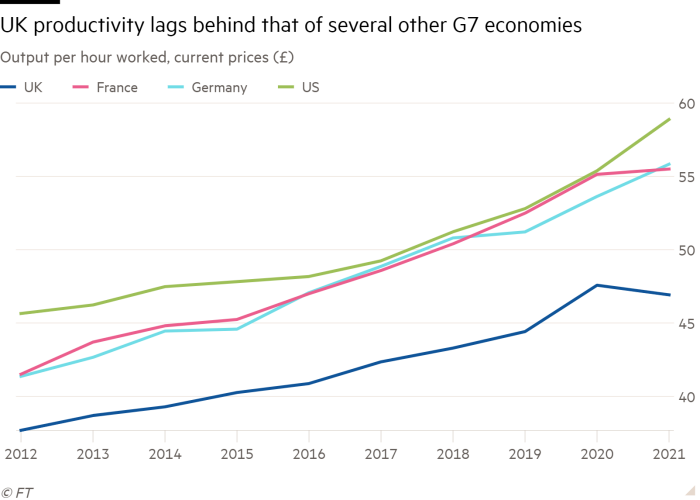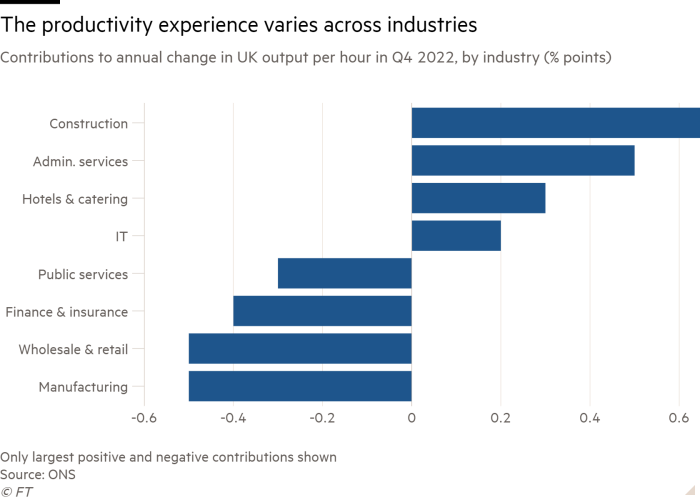For the past three years, successive shocks have buffeted the UK economy. Covid-19 drove consumers online, office workers to their kitchen tables and older workers into retirement. Energy prices rocketed, while Brexit rewrote the rules of trade and immigration, reshaping the labour market.
Yet the latest official data suggests this upheaval has made very little difference to the trajectory of UK productivity — the crucial factor that will determine living standards over the long term.
Figures published last week by the Office for National Statistics showed output per hour worked, the critical measure of labour productivity, was 2.1 per cent above its 2019 average in the final quarter of 2022.
The data made for the first reasonably reliable picture of how UK productivity is faring in the aftermath of the pandemic, since previous figures were distorted by Covid lockdowns and job support schemes.
It suggests the weak trend that has weighed on UK living standards since the 2008-09 global financial crash is essentially unchanged. This is a surprise given the extent of change in the economy and the way businesses operate.

Policymakers at the Office for Budget Responsibility, the independent fiscal watchdog, and the Bank of England initially warned Covid risked depressing productivity for years. They said the crisis had denied companies chances to invest or innovate while workers who lost or moved jobs would be unable to make the most of their skills.
Other economists had hoped the pandemic might have the opposite effect — delivering a productivity windfall as recession sent weaker businesses to the wall and jolted survivors into adopting technology and practices faster than they would otherwise have done.
“It is one of the puzzles of the pandemic,” said Grant Fitzner, ONS chief economist. “Typically, major crises lead to major structural change.”
Weak productivity growth is a huge problem, in view of the UK’s low starting point. International comparisons suggest the US, France and Germany produce about one-sixth more than the UK per hour worked. As Fitzner told a House of Lords committee last month, countries with such a step-up in productivity “can afford higher rates of tax, they can afford to pay for better public services, and they can probably afford to have a better standard of living”.

One theory for the unchanged trend in productivity is that the government’s Covid fiscal support, which kept businesses from bankruptcy and workers in jobs, prevented the process of “creative destruction” taking place. But other economists say the more likely explanation is that there have been both positive changes and big offsetting effects — and that the long-term result has yet to be seen.
Bart van Ark, head of the UK government-funded Productivity Institute, a research network, said that “if you focus on the macro number, you miss what is going on under the hood”. For many businesses, Covid lockdowns brought an “instant upside” in productivity, he said, because they led to overnight adoption of existing technologies to meet online, communicate with teams or share documents.
Greg Thwaites, research director at the Resolution Foundation think-tank, said subsequent staff shortages could also have prompted businesses to work more efficiently, even if they had not invested in labour-saving machinery.
There is anecdotal evidence to support Thwaites’s view: many pubs and restaurants have simplified menus because of the struggle to hire chefs, while haulage companies say a lack of drivers has led to much more streamlined work with supermarkets.
But individual companies are fighting to raise productivity in the face of short-term shocks and big structural headwinds. Business in some sectors, such as hotels, has only just returned to normal, while productivity gains in energy-intensive sectors including manufacturing have been eroded in the past year.

Paul Mortimer-Lee, research fellow at the National Institute for Economic and Social Research, a think-tank, said the UK had over time made a “societal choice” to focus on sectors with typically slower productivity growth, rather than reviving manufacturing, which has greater potential. It had therefore entered the pandemic “with pre-existing conditions, to use the Covid analogy”, he said.
One of the biggest headwinds has been the entry into force of the UK’s post-Brexit trading rules. The BoE always said these barriers would weigh on productivity in the long term but it now thinks the effects are feeding through faster than originally expected.
Brexit, Covid and the energy shock have all deterred businesses from making the investments in IT, machinery and other equipment needed to lift workers’ performance. The BoE, which previously thought productivity growth would pick up, now expects no improvement before 2025.
These are problems ministers could address, Thwaites argued, by negotiating better terms of trade with the EU and giving businesses lasting tax incentives to invest, as well as by redoubling the efforts of successive governments to reform planning rules and boost workforce skills. “A large part of it is within our control.”
In his spring Budget, chancellor Jeremy Hunt announced a three-year, £27bn tax relief programme aimed at increasing company investment, as well as measures intended to boost the UK workforce. But the OBR took the view that unless the tax break became permanent, it would simply lead businesses to accelerate investments. It would not change the capital intensity of the economy, or the path of productivity.
Even without government intervention, some economists predict a rebound in productivity across advanced economies as the forces unleashed by the pandemic start to take effect. So far, the most far-reaching change — the widespread adoption of hybrid working — does not seem to have helped or harmed productivity to a significant degree, measured as output per hour worked.
But global surveys suggest people split the time saved from commuting between work, leisure and care responsibilities, which should in theory boost productivity on the alternative output-per-worker measure.
Fitzner described this as “a rare occasion where a change in working practices has been positive both for workers and for employers”, with the latter having “a happier workforce working slightly longer hours”.
The recent breakthroughs in generative AI have fuelled hopes of a bigger productivity rebound, which would be slow to materialise but could transform rich economies.
“Productivity is a long-term metric,” said van Ark of the Productivity Institute. “The technology is there. The ability to generate skills, to have a better work-life balance, will be there. Some of the bad stuff has to go away.”
Stay connected with us on social media platform for instant update click here to join our Twitter, & Facebook
We are now on Telegram. Click here to join our channel (@TechiUpdate) and stay updated with the latest Technology headlines.
For all the latest Business News Click Here
For the latest news and updates, follow us on Google News.
